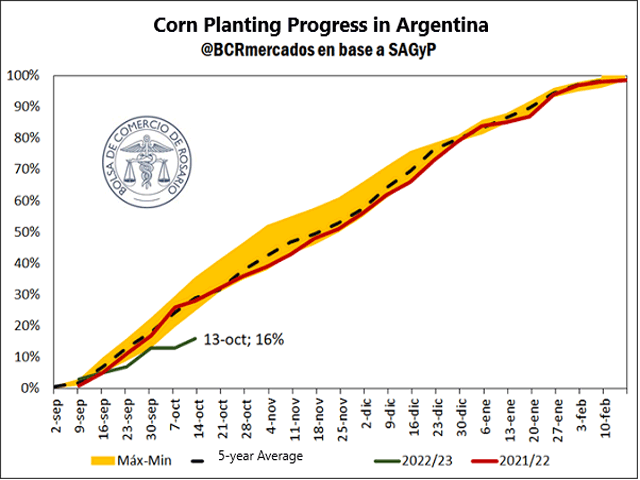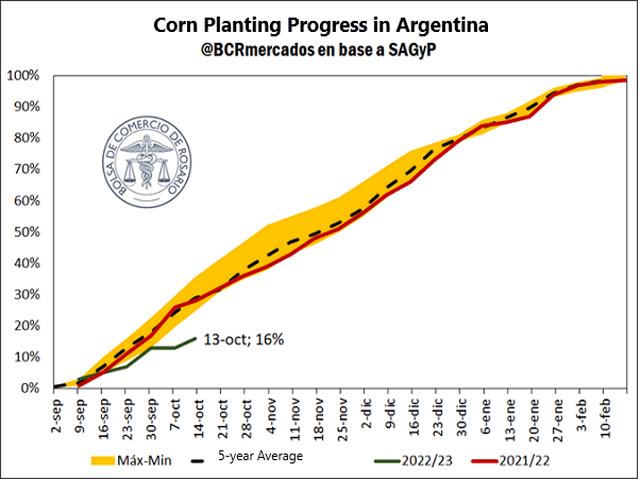South America Calling
Argentina Corn Planting Slowest in Six Years
Much attention has been given to Brazil and its weather this spring. Rightly so as the country is forecast to have major increases in production of both corn and soybeans from last year, easily eclipsing records should the weather cooperate. So far, it has.
That is not the case in Argentina. Typically bogged down with dryness and above-normal temperatures due to La Nina, the dryness has certainly come true. Rainfall estimates for Argentina's primary growing areas around the states of Cordoba and Buenos Aires are less than 50 millimeters (about two inches) in the last 60 days. That is about 20% to 50% of normal, following additional months of dryness during the winter that continued drought concerns from last growing season.
With drought and occasional freezes moving through this spring, corn planting has gotten off to an abysmal start. According to the Rosario Exchange, corn planting in Argentina has only reached 16% as of Oct. 13. The five-year average is about 30% and the overall planting pace is about two weeks behind schedule, or the slowest pace over the last six years. The first phase of corn planting ends at the end of October, where roughly half of the crop is planted. The second half starts in December and goes through mid-January. Soybean planting typically starts up around this time of the year with the main planting month of November. Perhaps waiting on rains, producers may be waiting to plant during the second phase or shifting their planting intentions to soybeans. As the Rosario Exchange notes, a mix of both is likely.
P[L1] D[0x0] M[300x250] OOP[F] ADUNIT[] T[]
Over the last few weeks, rains have been slow to increase, keeping behind the average pace, but they have been coming on at times. Rainfall Oct. 19 was widespread, but around 5 to 12 millimeters (0.20 to 0.50 inches) for most areas. That is not nearly enough to turn around the dry soils and allow for good seed-to-soil contact. Additional rains may come with a front Oct. 21-22 across Buenos Aires but amounts again should be light.
Models have recently increased their projection of another disturbance moving through Argentina early to mid-next week. Until recently, that disturbance looked devoid of showers. Now, models have been lighting it up a bit more as it crosses the country's growing regions. The output in the models is a little skeptical, however, and these showers may turn out to be more spotty than widespread -- but, again, it is something. Whether or not it will be enough for producers to increase their corn plantings in the first phase or not is questionable. There is only another week or so for them to do so. There are likely to be producers that have already made the decision to switch to soybeans and turning back may not be an option. Or seeing the long-range forecast may prompt producers to ignore the upcoming showers.
Long-range forecasts continue to paint much of Argentina with near- to below-normal precipitation through November. The primary growing states of Cordoba and Buenos Aires have more of a chance at normal precipitation than farther north in the country. But, overall, the prospects for rains heavy enough to turn around the drought conditions are very low. Of course, that does not mean precipitation will be entirely absent in the country for a whole month; but systems that do move through should come with less regularity and more scattered than widespread rains. Getting enough rain for corn to germinate and go through early development is going to be tough to get out of La Nina's grasp on the region.
As the third largest exporter of corn and soybeans, Argentina's weather also needs to be followed closely, not just the weather in Brazil.
**
For a more extended look at South American weather, join me at the 2022 DTN Virtual Ag Summit December 12-13. All of the information you expect from DTN, from the comfort of your home or office. For details on the agenda and how to register, visit www.dtn.com/agsummit
John Baranick can be reached at john.baranick@dtn.com
(c) Copyright 2022 DTN, LLC. All rights reserved.






Comments
To comment, please Log In or Join our Community .